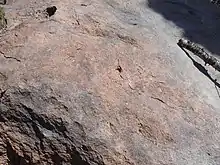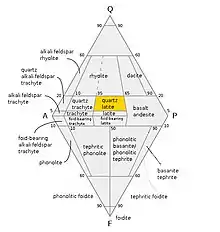Quartz latite
A quartz latite is a volcanic rock or fine grained intrusive rock composed mostly of alkali feldspar and plagioclase with some quartz. It forms from the rapid cooling of magma of intermediate composition but moderately enriched in alkali metal oxides.
| Volcanic rock | |
 A boulder of quartz latite from the Cerro Rubio plug, Jemez Mountains, New Mexico, USA. Field of view is about 50 cm. | |
| Composition | |
|---|---|
| Intermediate Major minerals: plagioclase, alkali feldspar, quartz |
Quartz latite is intermediate between latite and rhyolite in its mineralogy.
Description

Quartz latite is the fine-grained equivalent of a quartz monzonite, containing approximately equal amounts of plagioclase and alkali feldspar and between 5% and 20% quartz and with plagioclase making up 35% to 65% of its total feldspar content. Quartz latite is not a recognized rock type in the TAS classification used to chemically classify glassy or very fine-grained volcanic rock.[1][2][3][4]
Occurrence
Quartz latite is found in the 130-135 Mya Etendeka Formation of Namibia, where it forms extensive sheets in association with tholeiitic basalt. These are interpreted as densely welded ash flow tuffs.[5] Some of the quartz latite flows were enormous, with estimated volumes of 2,320 cubic kilometers (560 cu mi) and 6,340 cubic kilometers (1,520 cu mi) for two of the flows.[6]
Paleoproterozoic quartz latite is abundant in the Roxby Downs area of Australia, and may have been a source rock for younger granitoids.[7]
Quartz latite is found at the Bingham mine in Utah in association with its plutonic counterpart, quartz monzonite.[8]
References
- Le Bas, M. J.; Streckeisen, A. L. (1991). "The IUGS systematics of igneous rocks". Journal of the Geological Society. 148 (5): 825–833. Bibcode:1991JGSoc.148..825L. CiteSeerX 10.1.1.692.4446. doi:10.1144/gsjgs.148.5.0825. S2CID 28548230.
- "Rock Classification Scheme - Vol 1 - Igneous" (PDF). British Geological Survey: Rock Classification Scheme. 1: 1–52. 1999.
- "CLASSIFICATION OF IGNEOUS ROCKS". Archived from the original on 30 September 2011.
- Philpotts, Anthony R.; Ague, Jay J. (2009). Principles of igneous and metamorphic petrology (2nd ed.). Cambridge, UK: Cambridge University Press. pp. 139–143. ISBN 9780521880060.
- Milner, Sc; Duncan, Ar; Ewart, A (February 1992). "Quartz latite rheoignimbrite flows of the Etendeka Formation, north-western Namibia". Bulletin of Volcanology. 54 (3): 200–219. doi:10.1007/BF00278389.
- Ewart, A.; Milner, S.C.; Armstrong, R.A.; Duncan, A.R. (1 February 1998). "Etendeka Volcanism of the Goboboseb Mountains and Messum Igneous Complex, Namibia. Part II: Voluminous Quartz Latite Volcanism of the Awahab Magma System". Journal of Petrology. 39 (2): 227–253. doi:10.1093/petroj/39.2.227.
- Creaser, Robert A. (September 1996). "Petrogenesis of a Mesoproterozoic quartz latite-granitoid suite from the Roxby Downs area, South Australia". Precambrian Research. 79 (3–4): 371–394. doi:10.1016/S0301-9268(96)00002-2.
- Parry, W. T.; Ballantyne, G. H.; Wilson, J. C. (1 November 1978). "Chemistry of biotite and apatite from a vesicular quartz latite porphyry plug at Bingham, Utah". Economic Geology. 73 (7): 1308–1314. doi:10.2113/gsecongeo.73.7.1308.